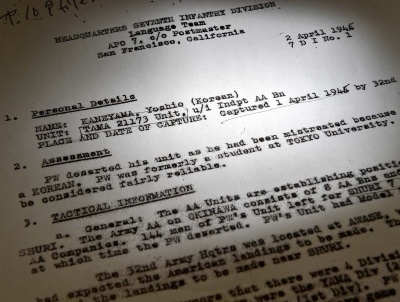Testimony by Japanese soldier of Korean descent tells of abuse by fellow soldiers

Record of testimony given by a prisoner of war of Korean descent captured by the U.S. forces who landed on Okinawa Island on April 1, 1945
April 1, 2016 Ryukyu Shimpo
By Hideki Matsudo
U.S. forces landed on Okinawa Island on April 1, 1945, marking the start of the Battle of Okinawa. On March 31, 2016, Ryukyu Shimpo obtained a written record of testimony made by a Japanese soldier of Korean descent who had been captured by U.S. troops in Okinawa on the day that they landed. It appears that the Korean soldier was the first prisoner of war captured by U.S. forces on Okinawa Island. The document in question was found at the U.S. National Archives. The Korean soldier told his questioners that he had fled due to unbearable abuse he received in his unit, and that the Japanese troops had headed toward Shuri on March 25, seven days before the U.S. landing. His testimony is consistent with records of Japanese military actions compiled after the war. The document also shows that the U.S. troops gained an accurate understanding of the Japanese military’s movements by questioning prisoners of war starting on the very day they landed on Okinawa Island.
While there were likely more than ten thousand Korean nationals conscripted to fight in the Battle of Okinawa, there is hardly any first-hand testimony about them, and details remain unknown. Okinawa International University professor emeritus and scholar of the Battle of Okinawa Masaie Ishihara says it is very rare to find evidence of activity or testimony by Korean nationals mobilized to fight in the Battle of Okinawa.
The record of the soldier’s testimony is one page long. It states the prisoner’s name as “’Kaneyama Yoshio’ (Korean)” and says he belonged to the 80th Field Antiaircraft Artillery Battalion under the 32nd Army command. According to the document, Kaneyama had been a student at Tokyo Imperial University.
The testimony was recorded by an American officer on the language team of the 7th Infantry Division that landed on Okinawa on April 1. It says that Kaneyama had left his unit on March 25, 1945, seven days before he was captured. The reason he gave for fleeing was that he had been treated badly in the unit due to being of Korean descent.
The record also includes information about Japanese military strategy, including information that the Antiaircraft Artillery Battalion was building an encampment near Shuri. This shows that the U.S. military had information that the Japanese military would be centered near Shuri.
The document also lists as secondhand information the prisoner reported having heard that four divisions were deployed on Okinawa Island, including the Yama unit, Take unit, and Tama unit. The U.S. military appears to have been gathering important military information from the prisoner in order to plan its own military strategy.
The testimony also includes details about the movement of civilians. It says that all men were conscripted for military-related work, and all other civilians were sent to the northern part of Okinawa Island while the Japanese troops made their way to the southern part of the island.
(English translation by T&CT and Sandi Aritza)
Previous Article:Okinawan novelist released after being held for 8 hours in US military base
Next Article:Regional opinion poll reveals opposition of 58% to Henoko relocation and 68% to Futenma Air Station remaining in place
[Similar Articles]
- 90-year old former student recalls history of Battle of Okinawa remains in Shuri Castle grounds
- Family of Korean war victims faces difficulty in getting names inscribed on Okinawa Cornerstone of Peace Memorial
- Editorial: Unforgivable destruction at Chibichiri-gama desecrates the spirit of “nuchi du takara”
- Okinawa Prefectural Archives releases 580,000 pages of Battle of Okinawa-related US military documents
- Governor explains OPG did not address rape by US Marine late last year “For the sake of protecting the privacy of the victim”
 Webcam(Kokusai Street)
Webcam(Kokusai Street)


